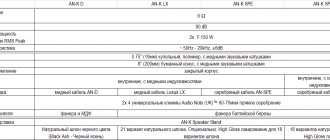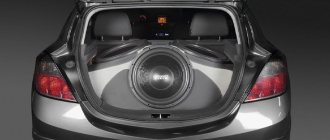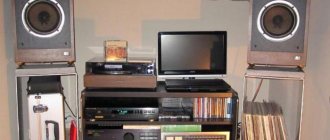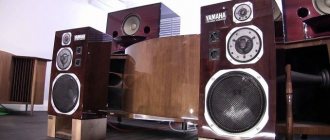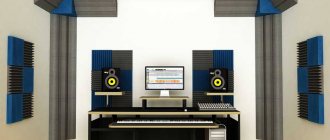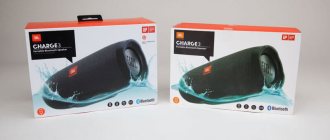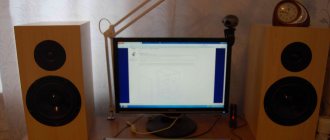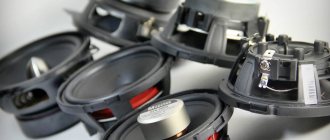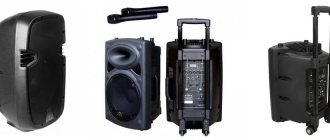Castle Acoustics - British-made acoustic systems and speakers in a wide price range. Castle Acoustics Corporation opened in 1973, at the same time it became the owner of the logo and name of the legendary eleventh-century fortress Skipton Castle, located in North Yorkshire, in the town of Skipton. This locality is where the company was founded. Historical traditions continue to this day in Skipton's Pennine hills, with artisanal traditions being the cornerstone of the Castle philosophy, which is harmoniously combined with innovative advances in cabinet design and speaker manufacturing technology.
Castle products, like musical instruments, are created by the best and most talented craftsmen dedicated to what they love.
Country of origin: UK
Castle
Set of speaker systems for home theater and music
Having tested the Classic sub active subwoofer, we couldn't stop there. Today in our test laboratory is a set of Castle bookshelf speakers capable of sounding a medium-sized room. The set is composite (we took several models from one line), so it can be configured differently if desired.
As you can see in the photo, the set consists only of bookshelf speakers and a center channel speaker, despite the fact that the Classic line is quite extensive: 3 models of bookshelf speakers, 5 models of floorstanding speakers, 2 central speakers (a larger one is included in the test) and a subwoofer, which we have already tested recently. But we assembled the system only from bookshelf speakers for two reasons: firstly, most buyers of speakers in this price category will probably build a home theater in an ordinary medium-sized living room (15 - 25 m²), and secondly, bookshelf speakers are still a little easier to place in the room, and visually they will not take up much space, even if they stand on special floor stands (that is, they will occupy the same space as their floor counterparts). And, thirdly, in a room with a relatively small area, the bass of bookshelf speakers will be perceived more comfortably, which will have a positive effect on the perception of sound as a whole. This is about music. In a theater, in any case, you will have to use a subwoofer, which means deeper and more powerful floor-standing speakers will not be a joy in relatively small rooms. So, bookshelf acoustics for relatively small rooms can quite rightly be considered the optimal choice. However, there is also an intermediate category of “compact floor-standing speakers”, but there is a separate conversation...
Castle Warwick 3
Two-way bookshelf speaker system. The design of the front panel could be called classic, if not for the swivel-shaped shape of the protective grille (this is a signature feature of almost all Castle speakers), as well as the “inverted” arrangement of the speakers, when the tweeter is located under the bass/midrange driver. In addition, the high-frequency speakers are shifted slightly to the side, and this is done in a mirror manner on the left and right speakers. The user can choose according to his taste how to position the speakers: with the tweeters facing outward or inward, especially since there is no marking indicating whether it is a right or left speaker. However, during listening, we placed the speakers as can be seen in the photograph - that is, the HF drivers were “inside” the stereo base. Another important point is the front bass reflex port, which allows, if necessary, to place the speaker quite close to the wall or even in a niche.
Having started the description of Warwick 3 with the design, we completely forgot to talk about the external decoration, and believe me, it’s worth talking about. The official distributor of Castle in Russia (A&T Trade) reported that three color options are possible: “regular” - as in the photo (natural veneer), or one of two “deluxe” options: yew or rosewood veneer. Of course, the deluxe finish is a little more expensive than the standard one, because it looks amazing. However, even with the “ordinary” finish, the appearance of the speakers is very attractive and memorable.
On the rear panel there is a block of connectors that allows the use of traditional “audiophile joys”: namely, a four-cable connection and banana connectors. Of course, no one bothers you to use a conventional two-cable connection, clamping the exposed wire with a screw terminal, as many do.
Inspection of the “underhood space” made an extremely favorable impression on us. It’s worth starting with the fact that the designers struggled with various resonances and vibrations in a comprehensive manner, using as many as three methods of acoustic optimization of the internal space of the case. The first thing that catches your eye is the absorber, which in this case is made not of padding polyester, but of sheet foam rubber approximately 2.5 cm thick. As you understand, it was removed during filming. This sheet of foam covers all the walls of the speaker, including the bottom. After its dismantling, the body panels veneered from the inside are revealed: a “sandwich” of veneer, MDF sheet and plywood sheet is used. This layered panel is very resistant to resonances and vibrations. And finally, on the side walls we found sheets of bitumen (!), which is known to be an absorber of the lowest frequencies and a damper that reduces possible vibrations of the housing wall at the same time. This approach of developers to the design of far from the most expensive speakers makes us just take off our hats. Although, the pleasant surprises are not over yet.
The wiring inside the speakers is made with a fairly thick (about 2 mm² cross-section) OFC (Oxigen Free Copper) cable. The cable is also original, from Castle.
Castle acoustic systems can be called “purely English”, because the body, speakers, and many components are developed and manufactured at Castle’s own facilities in England. But now we are interested in the speakers.
A driver with a metal diffuser holder, a 150-mm carbon fiber diffuser (the same material from which the ultra-light and very durable F1 car bodies are made), a phase-compensating dust cap in the form of a bullet tip (polymer cap) and a shielded magnetic system are responsible for the reproduction of low and medium frequencies. , allowing you to place the speaker literally right next to a CRT-based TV.
The high-frequency driver has a 19-mm dome diffuser made of polyamide, which is also quite unusual, especially for this class of speakers.
| CASTLE Warwick 3 | |
| Technical characteristics (passport) | |
| Acoustic design | Bass reflex port (front panel port) |
| Recommended amplifier power | up to 110 Watt |
| frequency range | 50 Hz - 20 kHz (unevenness not specified) |
| Sensitivity | 89.5 dB |
| Resistance | 8 ohm |
| Filter cutoff frequency | no data |
| Dynamic emitters | LF/MF: cone diffuser (150 mm in diameter) made of carbon |
| HF: dome diffuser (19 mm in diameter) made of polyamide | |
| Terminals | 2 pairs of banana jack screw terminals |
| Magnetic shielding | Yes |
| Are common | |
| Housing material | MDF with double-sided veneer |
| Dimensions (H×W×D) | 440×210×240 mm |
| Weight without packaging (pcs.) | 9.6 kg |
| Price* per pair | $745 (as pictured) $850 (yew or rosewood veneer) |
* recommended price from the official distributor in Russia
Measurement results
The frequency response graph shows noticeable irregularities throughout the entire frequency range. It is very difficult to predict the sound of speakers in advance based on this graph. Now we can only talk about the absence of serious distortions in the tonal balance. A slight rolloff in the region of 5-8 kHz can lead to a more restrained sound for many instruments, but aggression at high frequencies is not expected.
We remind you once again that the graph of frequency response and distortion is provided only to identify obvious possible shortcomings and some features of the tonal balance. A complete picture of the sound can only be given by long-term listening to various musical materials.
The level of distortion at low frequencies is several percent (which, in principle, is not that much), and after the 300 Hz mark it drops below 1%. Good result.
Frequency response measurements at an angle of 45° in the horizontal plane did not reveal any problems with sound dispersion in space.
Castle Richmond 3
These compact speakers are almost half the height of the solid and solid Warwick 3, however, despite their modest size, the Richmond 3 can easily work as a front pair if you plan to sound a very small room with an area of 12-15 m².
The bass reflex port is located on the rear panel, which does not allow the speakers to be placed close to the wall. This fact may complicate the process of installing speakers in small rooms, especially if the Richmond 3 will be used as rear speakers.
You can estimate the size of the speaker systems from the picture.
A four-cable connection is not provided. Only a traditional two-cable connection is possible, but banana connectors can also be used in this case.
Since the Richmond 3 is almost half the price of the luxurious Warwick 3, we didn’t really expect to see equally serious sound absorption measures. but they were partially mistaken. The internal veneer is still there (commendable for a $450 speaker), but we can no longer find the bitumen absorber. The role of a traditional sound absorber is the usual padding polyester. The fact is that, in addition to the price, there is also a factor of expediency: the Richmond 3 case is quite compact, and the low-frequency output of these speakers is noticeably less than that of the Warwick 3, so it is quite possible to assume that in There was simply no need for bitumen sheets.
It is gratifying that this relatively inexpensive speaker uses exactly the same high-frequency driver (19-mm polyamide dome) and a similar woofer/midrange driver with a carbon cone, cast base and bullet-shaped cap. But in this case there is no magnetic protection, and the diameter of the diffuser has become slightly smaller - its diameter is 130 mm. The only thing worth noting is the very low sensitivity of the speaker. At a frequency of 1 kHz it is only 86 dB. This means that you will have to look for a more “muscular” amplifier that can “drive” these speakers.
| Castle Richmond 3 | |
| Technical characteristics (passport) | |
| Acoustic design | bass reflex (port on the rear panel) |
| Recommended amplifier power | up to 70 Watt |
| frequency range | 65 Hz - 20 kHz (unevenness not specified) |
| Sensitivity | 86 dB |
| Resistance | 8 ohm |
| Filter cutoff frequency | no data |
| Dynamic emitters | LF/MF: cone diffuser (130 mm in diameter) made of carbon |
| HF: dome diffuser (19 mm in diameter) made of polyamide | |
| Terminals | 1 pair of banana jack screw terminals |
| Magnetic shielding | No |
| Are common | |
| Housing material | MDF with double-sided veneer |
| Dimensions (H×W×D) | 280×165×190 mm |
| Weight without packaging (pcs.) | 4.6 kg |
| Price* per pair | $375 (as pictured) $450 (yew or rosewood veneer) |
* recommended price from the official distributor in Russia
Measurement results
In this case, the picture is completely different. Oddly enough, at mid and high frequencies the frequency response is a little smoother than that of Warwick 3, but in the lower middle it’s the opposite. I was also a little surprised by the increase in the distortion level to several percent in the range of 1.5 - 6 kHz (Warwick 3 in this range has a distortion level noticeably less than 1%). This may cause a slight “squeezing” effect in the sound.
There are no problems with the frequency response obtained at an angle of 45° in the horizontal plane - it does not differ much from the one that was obtained on the axis, which means the speakers cannot be called highly directional - this is good.
Castle Bastion
Two-way center channel speaker with shielded magnetic speaker system. In terms of design and dimensions, this central speaker is somewhat reminiscent of the Warwick 3 model lying on its side (the same rounded edges of the front panel), only the protective mesh this time turned out to be a completely traditional rectangular shape. The dual bass reflex port is located on the front panel, which allows you to place Castle Bastion even in a niche or on a shelf under the TV. As in the two previous cases, the Bastion body is covered with natural veneer. And the deluxe finishing options (yew or rosewood veneer) are still offered.
The internal similarity with Warwick 3 is also obvious: sheet foam rubber as a sound absorber, additional veneering of the internal walls. There are no bitumen sheets.
While talking about the insides of the speakers we tested, we forgot to mention one detail: in the Warwick 3 and Bastion models, only soldering is used when connecting the crossover components and connecting the speakers. Even the wires to the speakers are soldered (most manufacturers limit themselves to using simple crimp-on removable terminals), which added a little more “weight” to the speakers in our eyes.
| Castle Bastion | |
| Technical characteristics (passport) | |
| Acoustic design | Bass reflex (dual port on the front panel) |
| Recommended amplifier power | 25 - 150 Watt |
| frequency range | 65 Hz - 20 kHz (unevenness not specified) |
| Sensitivity | 88 dB |
| Resistance | 8 ohm |
| Filter cutoff frequency | no data |
| Dynamic emitters | Bass/midrange x 2: cone diffuser (130 mm in diameter) made of carbon |
| HF: Dome diffuser (25 mm in diameter) made of fabric | |
| Terminals | 2 pairs of banana jack screw terminals |
| Magnetic shielding | Yes |
| Are common | |
| Housing material | MDF with double-sided veneer |
| Dimensions (H×W×D) | 195×486×240 mm |
| Weight without packaging (pcs.) | 10.3 kg |
| Price* for 1 piece. | $485 (as pictured) $580 (yew or rosewood veneer) |
* recommended price from the official distributor in Russia
Measurement results
A slight dip in the region of 3-4 kHz can slightly reduce the “brightness” of the sound, although the graph in the rest of the range cannot be called particularly smooth. However, you have to wait until you listen, because the frequency response graph is not able to give a complete picture of the sound of the speakers.
The situation with distortion is similar to the Warwick 3 model: a few percent at the low end, less than 1% after the 300 Hz mark.
Sound in music
Now is the case when two pairs of speakers (Warwick 3 and Richmond 3) turned out to be close in sound character, but still different in some aspects, so we will talk about each model separately. Let's start, oddly enough, with the little Richmond 3. In fact, there is no catch here, it just so happened that we listened to them first, so we will talk about them first, so as not to break the chain of impressions received from the speaker systems Castle.
Richmond 3 auditions were held in two stages. The first one is traditional. That is, the usual listening in a special room. The speakers are located at a distance of approximately 3 meters from the listeners. The speakers are installed on 60 cm backfill stands.
We drove all our test units for quite a long time to understand that the speakers are quite “omnivorous” in terms of music genres. At least you can listen to jazz, classical and rock quite comfortably. Richmond 3 has a number of advantages that allow us to rate the sound quite highly, despite a number of shortcomings. It would seem that the speakers do not have memorable dynamics; they shape the space well, but they are also nothing special; they do not amaze the imagination with either the detail of the sound or the depth of the bass. But on the other hand, the Richmond 3s have a surprisingly comfortable tonal balance, good attack, and excellent recognition of the timbres of instruments and voices - in this regard, the speakers add almost no “add-on” to the sound. But what is most captivating is the almost complete absence of “droning” when playing almost any music, which is why there is absolutely no tension when listening. The disadvantages of the Richmond 3 include a certain lack of dynamics (one gets the feeling that a dynamic range compressor is included in the path), as well as an emphasis on midbass - somewhat stronger than we would like.
The second stage of testing was carried out at my home - the speakers were used as near-field monitors (seated at a distance of about 1 meter from the speakers, and the speakers themselves were located at face level). As you might expect, I didn’t like monitoring on the Richmonds (after all, these were not originally monitor acoustics), but listening to music turned out to be quite comfortable even at such a short distance. The absence of magnetic shielding did not affect the operation of the Viewsonic P95f monitor at all (the speakers were installed 20 centimeters from the monitor on small table stands with vibration isolation).
But it was much more interesting to “communicate” with the larger (and almost twice as expensive) Warwick 3. Let us remind you that they use a number of “goodies” that, for obvious reasons, are not in the simpler Richmond 3.
Warwick 3 demonstrated even greater versatility of sound, playing all (!) tracks of the test selection without a hint of “dislike” for a given genre or recording. Despite the size of the body, the bass was not as deep as it might seem, but it was very clear and very “fast”. However, the bass depth was not enough to fully reproduce recordings of organ music or reproduce the full depth of double basses in a symphony orchestra.
The tonal balance is also extremely comfortable, but the dynamics and sound stage of the Warwick 3 are noticeably better than the small Richmond 3 (not surprising).
The use of three degrees of sound absorption inside the body showed itself literally from the first minutes: there was no “mumbling” in the sound at all - a very rare case when, throughout the entire composition of “Spanish Harlem” by Rebekah Pigeon, we did not notice a single parasitic overtone or hint of “mumbling” (internal cabinet resonances), although we have long been accustomed to them, because the cabinet resonances of most speakers in this composition made themselves felt at least a little. And here - nothing. Only music.
The second thing that pleasantly surprised Warwick was its emphasis on barely noticeable sounds. In view of this. Most of the songs in the test selection sounded fresh and detailed. And after finishing the mandatory program, I decided to listen alone to some of my favorite discs from my home collection. To my surprise, I heard new sounds and nuances on some compositions, which I had somehow not paid attention to before even in good monitor headphones AKG K240DF. It’s all about the speakers’ ability to “pull out” barely audible sounds, which is why many compositions sounded new. Marvelous.
The sound of Warwick 3 can be described as very comfortable and accurate, with good attention to detail. Also worth mentioning: the speakers play very measuredly and rhythmically - it feels like there is a metronome built inside . In other words, the speakers do not bring their emotions into the sound, presenting it somewhat “dryly” and pedantically in English.
Sound in the theater
Everything that has been said about the sound in music can also be attributed to the theater abilities of the speaker. Since the central speaker is very close in design to the front pair, there were no problems with coordination.
Conclusion
After extensive testing of Castle speakers, we can confidently say that they are completely worth their price. Beautiful appearance and decent (albeit somewhat indifferent, “dry”) sound, combined with the absence of genre restrictions on the reproduced material, make these speakers a good choice for both an avid theatergoer and a music lover. But the system will be most appreciated by those who want to enjoy listening to music and watching movies on the same system.
We recommend using the kit in rooms with an area of 15 to 25 m². I would also like to say that the speakers really “open up” at average or slightly above average volume.
pros
- clear and comfortable sound of the entire system;
- very universal sound (both different music and movies are perceived equally well)
- Superb Warwick 3 sound
- correct coordination of speakers in the theater;
- solid appearance and high-quality finish;
- elaborate design.
- reasonable price.
Minuses
- the sound is a little lacking in emotion;
- Richmond 3 model has low sensitivity.
We thank A&T Trade for providing Castle speaker systems for testing
Acoustics Castle Knight 5
The sound is absolutely not tiring, even if you listen to music like Dream Theater all day long
- Manufacturer Castle Acoustics
- Made in China
- price, rub. 27000
- www.castle.uk.com
ACQUAINTANCE. The Castle brand has recently been owned by the British concern IAG Ltd. (International Audio Group), which also includes such well-known manufacturers as Audiolab, Mission, Quad, Wharfedale, etc. The Castle Acoustics company itself has been specializing in the production of speaker systems for a wide variety of purposes for more than 35 years. She independently develops dynamic heads and prefers unconventional design solutions. One of them, Twin Pipe Technology, is implemented in the older, fifth model from the new Knight line. This is a quarter-wave resonator, which allows you to expand the bass range without using a bass reflex and, accordingly, get a faster response of the diffusers to the incoming signal. In addition, this design allows for maximum simplification of separation filters.
Before installing the speakers, you will need to screw the base and massive spikes, packaged separately, to them. Between the body, in the bottom of which a large hole is made, and the base, gaskets are installed, i.e. the system is not sealed.
150mm drivers with carbon fiber diffusers and a phase-equalizing “bullet” in the center are used as bass and midrange drivers. The one-inch soft dome tweeter is mounted in the center of a wide flange that is slightly concave inward.
The quality of workmanship and finishing of the case is beyond any criticism, externally the systems give the impression of a solid and expensive thing.
LISTENING. It is clear why some manufacturers prefer unconventional acoustic design such as a labyrinth or Transmission Line. The sound of such speakers seems more harmonious and comfortable, it does not tire at all, even if you listen to music like Dream Theater all day long. Knight 5 gave this tough genre a completely adequate interpretation - with the highest intelligibility, an abundance of timbral components and a three-dimensional, also very detailed sound stage. Despite the noticeably weakened lower bass, the sound is spacious and assertive. At the same time, it does not load, mainly due to the natural, not drawn-out attack and detailed, but not overly contrasting, elaboration of the timbre of acoustic and electronic instruments. True, the overall tonal balance seems slightly shifted upward, but there is no sharpness or noticeable emphasis on the highs. I really liked how the tweeters work - they not only convey all the richness of the sound of the cymbals, but also create an aura around them, a light cloud of overtones. Accordingly, the atmosphere turns out to be light and airy, which is especially noticeable in chamber recordings. The piano is absolutely reliable; the smallest nuances are noticeable in the sound picture - rustling sounds, the clatter of keys, sounds coming from the hall. When a bass drum hits, the vibration of the membrane is felt, turning into a smoothly decaying aftersound.
PLEASED
High intelligibility, transparent upper range of timbres, comfortable and musical sound in general.
DISAPPOINTED
The overall tonal balance is slightly shifted upward.
Floor-standing acoustic systems 24,900 - 45,000 rub.
- Aleks S-90 Jubilee 35,000 rub.
- Castle Knight 5 RUB 27,000
- Cervin-Vega! CLS-12 RUB 28,740
- Energy Connoisseur CF-70 RUB 35,000
- Jamo C-607 RUR 33,000
- Magnat Quantum 607 RUR 37,000
- Monitor Audio Bronse BR6 RUB 29,700
- Yamaha NS-F700 45,000 rub.
- Measurements
share
Tags: CastleRecommended

